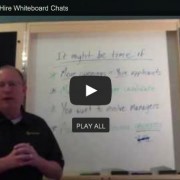What Should An Offboarding Process Look Like?
Onboarding and Offboarding can be tedious and confusing, Use ExactHire’s OnboardCentric to simplify and streamline these processes
Human resources professionals continue to maintain focus on the best practices for attracting, onboarding, and retaining top talent. But your company should also have processes in place for successful offboarding as well. Offboarding best practices, especially when implemented into your offboarding process, can help HR learn valuable insights. Learn more about what strategies and procedures you should be including in your offboarding processes, along with the advantages of having a dedicated set of steps and guidelines in place when it’s time to part ways with employees.
What Is Offboarding?
Often overlooked, the offboarding of an employee refers to the process involved when transitioning a former employee out of the company. Whether the employee is resigning, retiring, or management has decided termination is the best way forward, how an employee exits your company should have a dedicated process. Those processes may differ depending on the nature of the departure. But the existence of a strategized offboarding process is essential.
Why Is Offboarding Important?
Despite your best efforts, employee turnover is just an inevitable occurrence. Ultimately, your company will want to lay in procedures to shepherd those employee transitions gracefully, positively, and smoothly. It’s the offboarding process that will offer protections to avoid common mistakes for the employee and your company.
Here are just a few offboarding process benefits to consider:
- Prevents legal issues
- Mitigates company risks
- Streamlines employee exit logistics and timelines
- Allows for the collection of insightful feedback
- Ensures employees transition on the best terms possible
Offboarding Best Practices to Include in Your Strategy
As you sit down to create or improve your offboarding process, start with key steps. For example, develop a process for documenting the employee departure. This might include a signature on a formal resignation letter or employee termination description. Other first-step actions include scheduling an official exit interview, communicating with the remaining team members, and communicating with necessary clients. Consider creating a flow chart that includes these primary steps along with timelines and various applicable tasks determined by the nature of the departure.
What Offboarding Should Be
When carving out the steps for your offboarding process, be mindful to only include those necessary that:
- Improve the separation experience.
- Collect valuable insights that benefit HR.
- Ease any potential friction for other staff, clients, or colleagues.
- Protect your company assets.
- Grow or improve the company.
What Offboarding Should Never Be
As you evaluate your offboarding strategy, stick with only those steps that improve or streamline the process. An offboarding process should never be:
- A method of criticism to the separating employee
- A last-ditch effort to keep the employee from leaving
- An inauthentically nice formality without purpose
- A disrespectful or passive-aggressive confrontation
- A high-stress conversation
Offboarding Template and Checklist
For the most effective offboarding process and mutually beneficial experiences, consider following these checklist items and template suggestions.
Fairness and Respect: Every step and offboarding process enforcement should be conducted with transparency, fairness, and respect.
Loss Prevention: Every step should also be viewed through a lens of productivity, choosing the best methods for separating the employee in a way that does not impact company or departmental productivity.
Reason for Separation: The reasons for the employee separation should be agreed upon, signed off on, and well-documented.
Communication Chain: Include a series of professional communications to fellow team members, other company staff, applicable third-party vendors, and clients about the departure.
Property and Asset Management: Make swift arrangements regarding the reclaiming of company property and access removal from any company software platforms.
Transfer of Responsibilities: Prepare and allow for a transfer of knowledge and responsibilities, from training someone else to take on the role to briefing management regarding the status of projects or accounts.
Exit Interview: Create a process whereby a neutral party can facilitate an exit interview and encourage honest responses and feedback. Sample exit interview questions might include:
- What’s your favorite aspect of working here?
- Who do you admire here, in your department or otherwise?
- How would you describe your experiences with your direct supervisor?
- How would you describe your experiences with your co-workers?
- Did this job or role live up to your expectations?
- What could we have done better regarding your expectations?
- Please provide suggestions for areas of improvement.
- What is your impression of the company’s overall culture?
- What are we not doing that you believe we should be doing as a company?
Offboarding Made Easy with ExactHire
While your company and HR teams are always looking to improve hiring and retention strategies, don’t forget to develop an effective offboarding process. Take advantage of all the valuable insights you can gather from departing employees and implement improvements. Make adjustments and changes to streamline how you manage these engagements and protect company assets. And when you need additional guidance to change your approach to hiring, including best practices for offboarding processes, let ExactHire be your guide!









